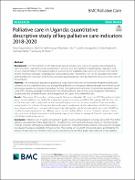| dc.description.abstract | The frst and most recent nationwide audit of palliative care services in Uganda was conducted in
2009. Since then, Uganda has made great strides in palliative care development, including policy, education, and
services implementation. This study provides an overview of the availability of palliative care services in the country
and the challenges and gaps in Uganda prior to the global COVID-19 pandemic. This lays the foundation for better
understanding the challenges and changes needed to support palliative care development and access in the wake of
the pandemic.
We conducted a descriptive quantitative study of secondary data on nationwide morphine distribution,
collated a list of accredited facilities, and analyzed key palliative care indicators collected through the mHealth surveillance project present at a subset of accredited facilities. Descriptive statistical analysis involved non-parametric tests
using SPSS, mapping geographical distribution of available palliative care services using Geographic Information
Systems software, and identifcation of challenges from the subset of accredited facilities.
Results: There were 226 accredited palliative care facilities across Uganda’s 135 districts in 2020. Thirty districts lacked
any accredited palliative care facility. The estimated population coverage was 88.5%. The majority (68.1%) of accredited facilities were public, and private facilities received slightly more pain-relieving morphine. There was an alternating trend in the volumes of morphine delivered to public and private facilities. More than a third of the patients
were diagnosed with non-communicable diseases, highlighting their signifcance alongside cancer and HIV/AIDS as
conditions requiring palliative care. Palliative care accredited facilities ofered six types of services: outreach, home
visits, psychosocial, legal, bereavement, and spiritual support, but only for an average of 7 months a year due to lack
of facilitation and transportation.
Palliative care in Uganda developed in quality, volume, and geographic coverage since 2009. The shift in
palliative care patients’ primary diagnosis from HIV/AIDS to non-communicable diseases marks an important epidemiologic transition. Although accredited facilities are present in most administrative districts, more research is needed
to evaluate the actual accessibility of these services. The existing services, both private and public, are limited by the
amount of pain-relieving morphine, fnancial and transport resources. More quality data collected on key palliative | en_US |


